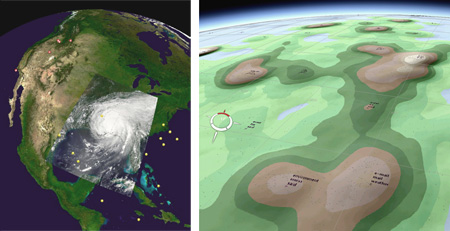Towards the Geospatial Web - Media Platforms for Managing Geo-Tagged Knowledge Repositories
Arno Scharl
![]() Download in PDF Format (408 kB)
Download in PDF Format (408 kB)
International media have recognized the visual appeal of geobrowsers such as NASA World Wind and Google Earth, for example, when Web and television coverage on Hurricane Katrina used interactive geospatial projections to illustrate its path and the scale of destruction in August 2005. Yet these early applications only hint at the true potential of geospatial technology to build and maintain virtual communities and to revolutionize the production, distribution and consumption of media products. This chapter investigates this potential by reviewing the literature and discussing the integration of geospatial and semantic reference systems, with an emphasis on extracting geospatial context from unstructured text. A content analysis of news coverage based on a suite of text mining tools (webLyzard) sheds light on the popularity and adoption of geospatial platforms.

Figures and Tables
- Figure 1.1: Data integration with NASA World Wind and Google Earth
- Figure 1.2: Thematic mapping (Cartia, knowledge planet prototype)
- Figure 1.3: Interfaces for accessing geo-referenced news archives
- Figure 1.4: Media coverage of geospatial platforms
Quote from Introduction (Page 3-4)
"Kathryn O'Reilly is a freelance editor who sells her ability to gather, filter and prioritize electronic content. In a virtual world built on contextualized information spaces, Kathryn seamlessly switches between geographic and semantic topologies. She begins her typical working day floating in the virtual space above Earth, ready to navigate the globe and semantic structures via subtle movements of her eyes. An extensive portfolio of add-on functionality is accessible through haptic devices. From her elevated position, Kathryn not only observes the rise and decay of topics, but also the unfolding of social structures based on the unique social networks of her friends and business contacts. Across these networks she builds and shares her knowledge repository and composes media products that are continuously being validated and enriched by the latest news feeds and third-party sources. The underlying content management system tailors the format of her articles to the changing preferences of her regular readers. Kathryn adds, selects, categorizes, aggregates, filters and extrapolates information along multiple dimensions, with minimal cognitive requirements. She can structure her daily workflows, access archives of historic textual and multimedia data and customize her virtual environment. Adaptive communication services allow her to interact with predefined or dynamically assembled groups of like-minded individuals. At any point in time, Kathryn may use portions of the information space to initialize simple what-if scenarios or advanced socioeconomic simulations, investigating the complex interplay among computer-generated avatars, automated information services and real-world participants".

The Geospatial Web ▪ Copyright 2007 Springer ▪ ISBN: 1-84628-826-6


